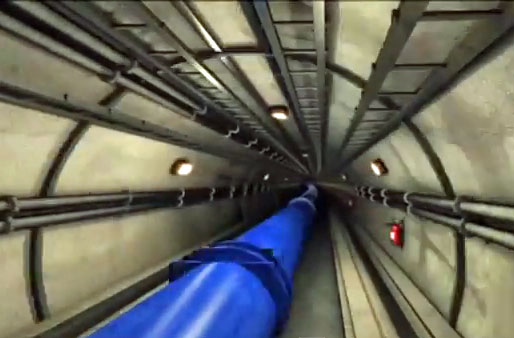
What Would Happen If You Put Your Hand in the LHC Beam?

In this weekly series, Life's Little Mysteries provides expert answers to challenging questions.
A crown achievement of science, no doubt, but the Large Hadron Collider is a little tough for us regular folks to wrap our heads around.
At full throttle, a beam of protons will whiz through the LHC's tunnel at 99.9999991 percent the speed of light, for example — but what do all those 9's actually mean? Moreover, that beam will smash into another beam traveling equally fast in the opposite direction, stopping protons dead in their tracks and causing their immense kinetic energy to convert into never-before-seen, incredibly massive particles via Einstein's famous equation E=mc^2 — but how fast are those protons really moving when they smack together?
One way to make an invisible beam markedly more tangible is to find out what it might feel like were it to run into you. What would happen if you stuck your hand in the beam? Sixty Symbols, video journalists with the University of Nottingham, have gone to Geneva, Switzerland, and asked LHC scientists this very question.
According to David Barney, a physicist who works on the CMS experiment at the LHC, the beam focuses the energy of an aircraft carrier in motion down to a width of less than a millimeter. "You really wouldn't want to put your hand in there. It'd make a hole straight through it," he said.
Steven Goldfarb of the ATLAS experiment preferred a ground-based vehicle analogy: "There's a train going through there at full speed basically. That's the amount of energy that there is," he said, adding that the beam has instantly bored holes through pieces of metal set in its path.
But a hole-in-the-hand isn't the worst of it. "The proton beam is accompanied by what's called a 'halo' of electrons and some muons as well … some of which can be meters away," Barney said. "So there's an intense beam of particles coming down [the tunnel] that accompanies this extremely intense part. So your whole body would be irradiated. You'd die pretty quickly."
Sign up for the Live Science daily newsletter now
Get the world’s most fascinating discoveries delivered straight to your inbox.
The fatal event would be more of a fizzle than a bang. "I don't think it would explode your hand," Barney said. "I don't see any mechanism for that."
Follow Natalie Wolchover on Twitter @nattyover. Follow Life's Little Mysteries on Twitter @llmysteries, then join us on Facebook.
Natalie Wolchover was a staff writer for Live Science from 2010 to 2012 and is currently a senior physics writer and editor for Quanta Magazine. She holds a bachelor's degree in physics from Tufts University and has studied physics at the University of California, Berkeley. Along with the staff of Quanta, Wolchover won the 2022 Pulitzer Prize for explanatory writing for her work on the building of the James Webb Space Telescope. Her work has also appeared in the The Best American Science and Nature Writing and The Best Writing on Mathematics, Nature, The New Yorker and Popular Science. She was the 2016 winner of the Evert Clark/Seth Payne Award, an annual prize for young science journalists, as well as the winner of the 2017 Science Communication Award for the American Institute of Physics.











